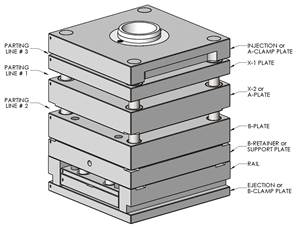UV Cure Solves LSR Processing Challenges
Close Up: LSR
Extended cure times for thick parts and temperature sensitivity of pharmaceutical additives are two challenges for silicone molding and extrusion that can be overcome with new low-temperature UV curing technology.
Extended cure times for thick parts and temperature sensitivity of pharmaceutical additives are two challenges for silicone molding and extrusion that can be overcome with new low-temperature UV curing technology. That’s the word from Momentive Performance Materials Inc., Albany, N.Y. (momentive.com), which showed off its new Addisil UV 60 EX elastomers at the MD&M West medical show in Anaheim, Calif., last month.
At MD&M, the new technology was presented by Specialty Silicone Fabricators (SSF), Paso Robles, Calif., with assistance by Momentive. SSF performed tests on LSR “combination products,” in which drugs are mixed into the silicone formulation for extended-release applications. Four different drugs (three steroidal types and one antibiotic) were tested in a 64 Shore A LSR, demonstrating that the drugs did not inhibit cure at room temperature. And NMR testing of cured LSR containing one anti-inflammatory drug showed that the UV process did not degrade the drug.
As explained by Mark Paulsen, ┤¾¤¾┤½├¢ development director of SSF, this is significant because many pharmaceuticals are sensitive to heat. “Low-temperature UV-curing of LSR has the potential to expand the scope of silicones in combination products and expand the range of drugs that can be used in them,” he said. While room-temperature vulcanizing (RTV) silicone elastomers offer an option, they cure very slowly—from 30 min to as long as three days. The UV LSR plaques in these tests cured fully in 40 to 100 sec.
HOW IT WORKS
Momentive’s Silopren UV LSRs and Addisil UV EX extrudable solid (HCR) silicone rubbers are two-part formulations that contain a UV-activated platinum catalyst. Momentive application development engineer Mel Toub says these materials can be cured with common UV lamps that emit light in the wavelength range of 315 to 430 nm.
UV curing of LSR does require transparent molds or cavity inserts. For extrusion, the UV light is provided externally using a modified lamp fixture, while molding requires transparent molds or cavity inserts. Tests so far have used machined blocks of acrylic for molds; Momentive and SSF are exploring more durable alternatives.
The LSR (or HCR) formulation must also be relatively clear but can accommodate bright, vivid transparent colors, as long as the pigments are compatible with platinum catalysts. Silopren UV LSR is available in 54, 64, and 68 Shore A hardnesses. According to Toub, properties are comparable to those of heat-cured LSRs. He notes that the UV-cure process has a number of other potential advantages: There may be no need for a water-cooled injection barrel or cold deck on the mold, which can reduce tooling costs. Since mold filling is accomplished at room temperature, there is virtually no risk of scorching. Low-temperature curing also means no pressure buildup in the mold and lower post-mold shrinkage. Toub says premixed UV-curable material has a long pot life, even under exposure to indoor fluorescent lighting (but sunlight must be avoided).
UV-cure extrudable silicone was first commercialized in Europe but is now also available here. Toub sees big opportunities in UV-cure LSR molding, not just for medical combination products, but also of thick-wall parts where current cure times are very long, and UV cure offers significant cycle-time reduction.
Related Content
What to Look for in High-Speed Automation for Pipette Production
Automation is a must-have for molders of pipettes. Make sure your supplier provides assurances of throughput and output, manpower utilization, floor space consumption and payback period.
Read MoreUsing Data to Pinpoint Cosmetic Defect Causes in Injection Molded Parts
Taking a step back and identifying the root cause of a cosmetic flaw can help molders focus on what corrective actions need to be taken.
Read MoreInjection Molding: Focus on these Seven Areas to Set a Preventive Maintenance Schedule
Performing fundamental maintenance inspections frequently assures press longevity and process stability. Here’s a checklist to help you stay on top of seven key systems.
Read MoreHow to Design Three-Plate Molds, Part 1
There are many things to consider, and paying attention to the details can help avoid machine downtime and higher maintenance costs, and keep the customer happy.
Read MoreRead Next
See Recyclers Close the Loop on Trade Show Production Scrap at NPE2024
A collaboration between show organizer PLASTICS, recycler CPR and size reduction experts WEIMA and Conair recovered and recycled all production scrap at NPE2024.
Read MoreBeyond Prototypes: 8 Ways the Plastics Industry Is Using 3D Printing
Plastics processors are finding applications for 3D printing around the plant and across the supply chain. Here are 8 examples to look for at NPE2024.
Read MoreLead the Conversation, Change the Conversation
Coverage of single-use plastics can be both misleading and demoralizing. Here are 10 tips for changing the perception of the plastics industry at your company and in your community.
Read More












